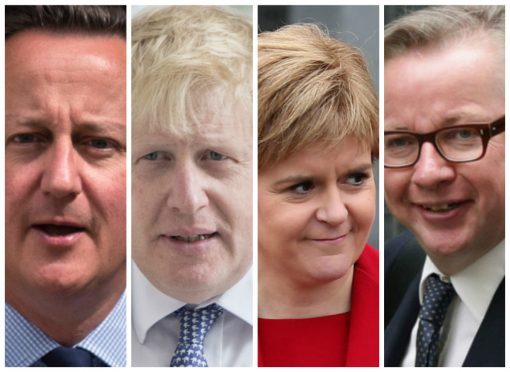As the dust settles on a dramatic referendum, Calum Ross asks whether history will repeat itself in the following hours, days and weeks.
For people in Scotland, much of the EU referendum campaign until now has been eerily familiar.
It has largely followed the same path as the independence referendum of 2014, although squashed into a shorter period of time.
Prime Minister David Cameron and his Remain camp clearly decided early on to follow the same strategy they had pursued with Better Together in the Scottish vote, presumably on the grounds that it worked for them in the end, despite the victory having been hard fought and won at a cost.
Project Fear – even the phrase was borrowed from Scotland – duly followed, and was met with repeated accusations of scaremongering from those on the Leave side, as it was two years previous.
The polls have been remarkably similar to the Scottish referendum in the run-up to the country’s date with destiny as well.
So it may be that the Scottish example offers an insight into what lies in wait in the hours, days, weeks and months ahead, if there is a narrow Remain vote, as the polls suggested last night.
Within moments of the Scottish referendum, Mr Cameron was in front of the TV cameras outside 10 Downing Street declaring that the result represented the “settled will” of Scotland.
It seems likely, in the event of a narrow vote to Remain, that the prime minister will once again move quickly to try to draw a line under an episode which has left the country, and his party, desperately divided.
In the same speech two years ago, the prime minister also vowed to deliver further devolution to Scotland.
If he has managed to keep the UK in the EU today, there may be echoes of the same sentiment as he pledges to continue to fight for further reform in Brussels, in an effort to try to appease the Outers.
A few hours after Mr Cameron’s speech on September 19, 2014, SNP leader Alex Salmond unexpectedly announced his intention to quit.
The move immediately stole the headlines back from Mr Cameron and the No camp’s victory, and served to intensify the frustration of Yes voters, who over the following days and weeks would flood the SNP with thousands of membership applications.
Most expect the prime minister to follow Mr Salmond’s example if the result is Brexit.
But might Michael Gove, Boris Johnson, and other senior figures, quit the UK Government in similar fashion to Mr Salmond over the next few days if the result is Remain?
It seems certain that some would. But where do they, and the millions of disgruntled Leave voters, go?
Ukip? Nigel Farage may also decide to fall on his sword, but his party is likely to experience a boost in support over the coming weeks, particularly if the result is Remain.
But while some Tories may defect to Ukip, more would be likely to decide to bide their time on the backbenches and build momentum for a bid to topple Mr Cameron, and pave the way for a second EU referendum.
The lessons of the Scottish referendum are still ringing in the ears of the Labour Party, meanwhile, and in many ways it is still paying the price for failing to learn them.
A huge section of traditional Labour voters backed independence – and then jumped ship to the SNP after the vote.
The nightmare scenario for Labour in England and Wales would be that history repeats itself, and the party’s working class base turns out en masse for the Leave camp, never to return.
Of course, politics has rarely been less predictable in an era where Jeremy Corbyn can become Labour leader and Donald Trump can secure the Republican nomination in the US presidential election.
The similarities between the Scottish and EU referendums may end today.
And if the Leave campaign scores a shock victory, then all bets are off as to what will unfold.
But, as with Scotland, it appears that whatever the result, Mr Cameron is likely to find out again that the politics of identity, once unleashed, can leave a country deeply divided and changed forever.
